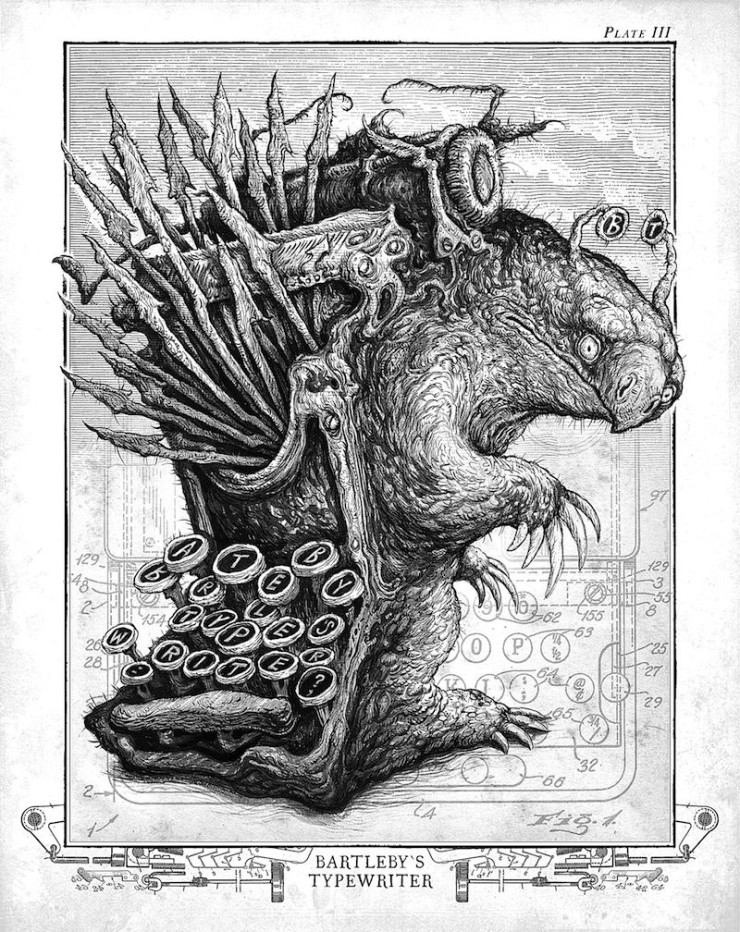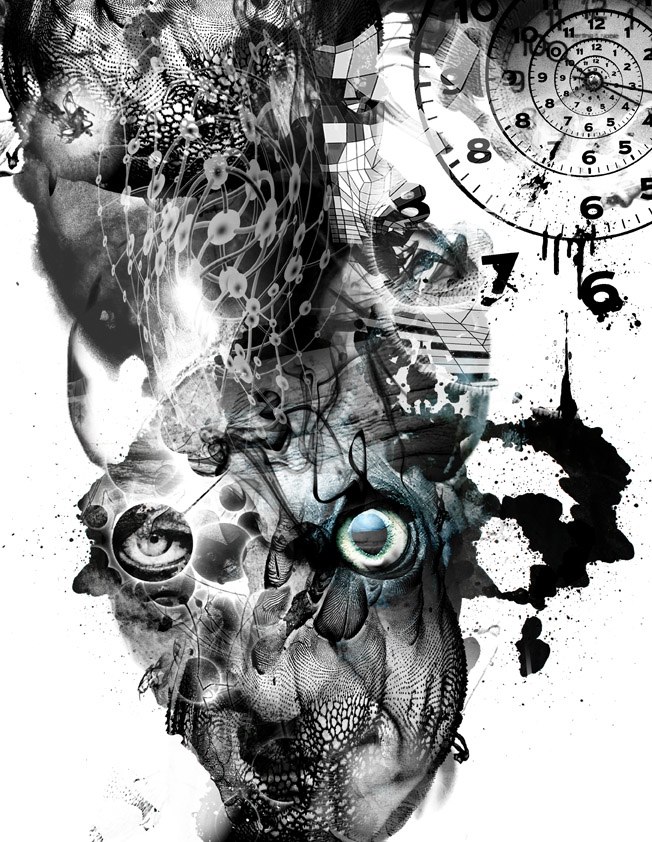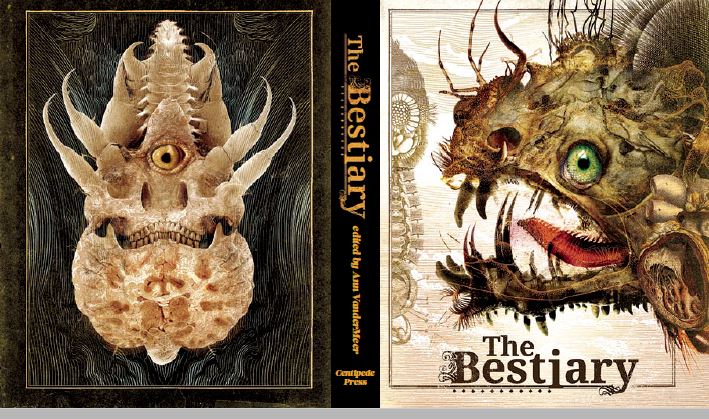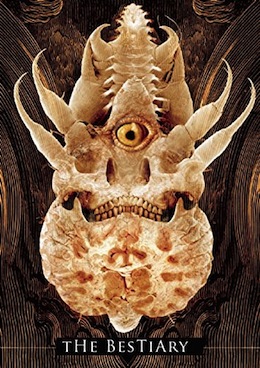This winter brings the release of The Bestiary, edited by Hugo Award-winning editor Ann VanderMeer. Containing 28 stories, The Bestiary is an A to Z of all-new fantastical beasts—with an ampersand creature and an animal with no letters in its name thrown in for a good measure—copiously illustrated by Serbian artist Ivica Stovanovic. Contributors include China Mieville, Catherynne M. Valente, Karin Tidbeck Rikki Ducornet, Amal El-Mohtar, Vandana Singh, and many more, from all over the globe! You can acquire this treasure in a beautiful hardcover from Centipede Press, publishing February 9th, or in e-book form through this StoryBundle running until the end of December.
But there’s more. In The Bestiary even an end note isn’t what you’d expect… To celebrate the release of The Bestiary, Tor.com is pleased to present the results of the contributors having all transformed themselves into imaginary beasts for their biographical sketches. Read all about the transmogrified authors below, and get a preview of Ivica Stovanoci’s interior art!
The Michal Ajvaz is a wild goat that spent his merry childhood and youth on Southern Crete, jumping on the rocks above the Libyan Sea. The last several decades he has lived in cold and boring Prague (he forgot already for what reason) and thinks back on the warm South and on the sea.
The Dean Francis Alfar is a red-bellied yellow-frilled reptile, whose range is limited to dense tropical areas. Prone to extended animated contortions and loud guttural utterances, other creatures have learned to use its startling antics to deflect unwanted attention from predators.
The Michael Cisco is an unconscious, flightless, featherless, beakless, voiceless, nocturnal bird made of lead that lives below the moon. It is a scavenger that eats luck. Only one exists. With a loud cry.
The Gio Clairval belongs to the recherché species known as Cilieagle (Linnean: Aquila cigliata), notable for her sharp metal tongue and liquid eyes. Curly cilia allow the Cilieagle to gather wriggling words while a thirty-foot wingspan gives her the ability to propel herself away, into many different kinds of stories. She soars screeching: “Aluminum, George!”

The larval phase of the Brian Conn flourishes in deserts and miasmata, being adapted to these divergent ecosystems and no others. Few of the larvae reach maturity, and those few spend the adult phase of their lives putting to rest their innumerable fallen siblings, the unquiet spirits of which are often mistaken for natural phenomena – sunspots, forgetfulness.
The Evolutionary Taxonomist Maury Mutterer renamed Mobble’s Amplified Reminiscent the Luxuriate Reminiscent. However, it was Manglehopper who recognized that the Amplified presented in a state of agitated self-mortification whereas the Luxuriate evidenced protracted bliss. Manglehopper proposed two distinct species. However, Mutterer, Mobble and Manglehopper were all misguided. The Amplified and the Luxuriate are one and the same. It is the Reminiscent’s moodiness that has so confused my elderly colleagues. I propose, therefore, that the Luxuriate and the Amplified be acknowledged as one distinct species to be named after me: Masterbander’s Reminiscent. (Rikki Ducornet)
Something of a disputed figure, experts can only agree that the Amal El-Mohtar appears to be half-woman, half-eagle and that she has exquisite taste in footwear. A chance encounter with an Amal led English playwright William Congreve to abandon the theatre for good at the age of 30. “I cannot tell what I know,” he wrote to a friend in 1706. “They say her shoes are beautiful enough to destroy the minds of men, but the truth is far worse.” (as recorded by Stu West)
The Brian Evenson or Bjorn is a large, pale Northern creature who becomes irritable when exposed to too much sun. It is happiest when fed on enormous quantities of food, cured meats in particular. Bjorns have been known to live in captivity largely on vegetables and salads, though the risk of them eating their zookeepers in such circumstances increases dramatically.
The Felix Gilman can be found nesting upside-down in the eaves of suburban homes throughout North America. It is chiefly notable for the owl-like tufts of its eyebrows, and for the protruding sesamoid bones on its hind feet, which act as rudimentary thumbs and allow it to use twigs as tools, to dig insects out of bark, to get into trash bags and scatter things about, to crack open windows and type long mad emails to local newspapers on other people’s computers, and to generally make a mess.
The L. L. Hannett or El-El is a pygmy possum with rose petal skin who wilts from pale yellow birth to wrinkled brown death over the course of one week. Her life is short but exuberant: she is the eucalypts’ most accomplished acrobat. For seven hot days and seven hot nights she swings from the trees’ peeling bark, loop-de-looping to keep herself cool on gusts of spicy air. At sunrise on the eighth morning, she lies down, closes her gumnut eyes, and sighs happily as her body disintegrates. El-El’s remains tickle Kookaburra’s throat as he swallows the last crumbs of her, his wild laughter suitably joyful for her funeral dirge.
The Karen Heuler or Heulertwit is a bird with a nattering squawk and an exact number of feathers which never seem to be exactly the feathers she thought she had.
The Richard Howard is a tiny creature that appears as a nugget of flesh with one eye that sinks itself into the loose topsoil of the forest floor. Its lifecycle is around eight months, during which time it produces enough fluid to clear its eye of dust and dirt for around ten minutes. During this brief revelatory time it blinks once, sending reproductive spores into the air to populate other parts of the forest. The origin of the Cyclops myth, the epic poet Homer is said to have always carried a Richard Howard about his person, with which he would amuse children by attaching it to his forehead with goose-fat.
The Rhys Hughes is the only known example of the aardvark-toucan. Half aardvark, half toucan, half badly added fraction, he tends to roam the most secret places of any landscape claiming to be able to hear the tectonic plates shifting over the formalin seas of Hell. Also he likes fruit. In the cool crepuscular gleam of the deep forest he whistles and hums at the same time, hoping to summon the giant banana canoe of the god Zumboo, with which to ply the fabled fruit juice rivers. Or so it is said. By me. Just now.

Stephen Graham Jones is what was left after all the ancillary, vestigial, and redundant appendages, tentacles, and antenna were excised. While the goal of that series of surgeries was a form more or less conforming to ‘human,’ at least in silhouette, results were not quite in keeping with expectations. However, in the right dim light, and with proper charitable squinting, and so long as he’s sitting reasonably still, the case of Stephen Graham Jones can probably be considered a success.
Also listed as Gaygayyem et Kadkadua Ni, the Rochita Loenin-Ruiz is a fluffy grey-brown creature no more than a hand’s breadth in size. Beloved by Ayudan’s garda for its gentle and playful nature, the Rochita can be a formidable foe once aroused and is quite ferocious in the defense of comrades. Its bite releases a poison that causes disorientation, loss of control, paralysis and eventual death. At rest, the Rochita enjoys snacking on rare manuscripts and illustrated texts.
The Karen Lord or Lesser Sable Kael is a small wildcat somewhat resembling a miniature panther. Though it is commonly found lounging comfortably on tree branches and quietly scanning the savannah for prey, it has phases of quasi-hibernation during which it nests in a cave on a bed of paper scraps, breathing infrequently, eating not at all, and oozing an inky liquid from its claws.
The Karin Lowachee or “Fenderstrat” is a sub-Arctic creature of the ursidae family. Its ability to pierce the air with its pure vocalizations has haunted the histories of ancient civilizations and gives rise to modern urban myths, wherein the call of the Fenderstrat is said to lure people to its hunting grounds. Some believe that the Fenderstrat also possesses the ability to predict the future, and scratches its portents into wood with its wire-like claws.
The China Miéville is a simple, crude crab made of twigs and bones.
The invasive species Micaela Morrissette or Xolu, introduced to Zone-5 climates for its ability to repulse the neurotoxic butterflies that became a serious threat in 2013, cannot be eradicated by traditional means. Uprooting, fire, frost, pH imbalance, pesticides, sonic waves—each attack increases the resilience of successive generations of this voracious land-anemone. The Xolu may be killed only by kindness; fauna gardeners who dedicate nine-plus months to exhaustive regimens of cooing, stroking, humming, kissing, cuddling, and consoling the unwanted organism should find their efforts rewarded. The Xolu will pale, droop, leak saline, wrap its tentacles around itself, and eventually shrink into the dirt.
The Reza Negarestani is the Mother of Abominations
The Joseph Nigg or Bookworm rarely emerges into daylight, preferring to live within the covers of books. It lives in the holes of both vellum manuscripts and more recent tomes, often in the subterranean archives of libraries and museums. Especially fond of palimpsests due to the layers of ink and their subtle flavors, it reads, digests, and excretes words. Microscopic analysis of its castings reveals everything that it has read.
The Dexter Palmer lives in the darkened corners of libraries, dining on ink and wood pulp. Its gestation period is unpredictably long; its offspring are unnatural, no two of them alike.
The Cat Rambo lurks in the thickets of the imagination, slipping among the leaves in a glimpse of gold feathers, then red. Hold still and you may see a wonder: a host of flames as the Phoenix dances, immolates, and is reborn to slip away again, leaving only scented ashes and laughter behind.

The Corey Red Ekop, enveloped within a miasma of apathy and shrouded in inconspicuousness, is remarkable for its unflinching refusal to take the hint and shove off. A relative of the Canadian ferret-badger that, at family gatherings, is inevitably seated at the children’s table, this mislabeled varmint (its pelt the flaccid hue of ancient vellum) lacks the territorial ferociousness typical of its genus, preferring to passive-aggressively unleash a volley of obnoxious missives to its local Member of Parliament. The red ekop is colloquially referred to as “the red hiccup.” When it is referred to at all. Which is seldom.
The Eric Schaller subsists almost entirely on a diet of pretzels, chips, and salsa. It has the disturbing habit of licking its fingers before it feeds rather than afterward. Perhaps it thinks it has already fed, that it is living its life backward. Its saliva is unusually sticky, and you would do well not to shake its hand even out of misplaced politeness because, in spite of its typical diet, the Schaller is an omnivore.
The Vandana Singh or Vandak is a short, ungainly animal tending to stoutness and irritability. Its hair sizzles constantly with electric discharges; touching it will give a person a nasty static shock. The Vandak is blue, with multicolored plumage and large, despondent eyes. Awake at all hours, it dreams incessantly of sleep.
The Karin Tidbeck is a conglomerate of homunculi thought to originate from a mandrake crop somewhere in southern Sweden.
The Catherynne M. Valente is a well-known griffin with excellent fur and bluish green feathers. Unfortunately, her tail is only so-so. She scratches out novels on sea walls with her talons and powerful but rather dented beak and runs a respectable cave for orphaned elephant seals.










